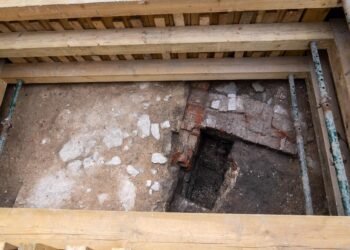In a remarkable archaeological discovery, over 3,000 ancient coins, including 700 still gleaming as if freshly minted, have been unearthed at the historic thermal baths in San Casciano dei Bagni, Italy. These coins, believed to date back to the second century AD, were reportedly cast into the waters by Roman Emperor Marcus Aurelius Carus as an offering to the gods for safeguarding his health and that of the Romans who sought the therapeutic properties of the thermal springs.
“The exceptional state of preservation at this site is unparalleled in the Mediterranean,” remarked archaeologist Jacopo Tabolli, the excavation’s scientific director and a professor of Etruscan studies at the University for Foreigners in Siena. “This discovery provides invaluable insights into how ancient societies viewed the healing properties of hot springs as being under divine protection.”
The significance of the artifacts recovered is profound. Residents of San Casciano have long regarded the area as a “sacred mountain,” with historical references dating back to the 16th century. A geophysical survey in 2019 revealed ancient structures surrounding the springs, leading to the unearthing of columns and the commencement of excavation—although work was briefly paused due to the pandemic.

The ancient baths functioned as a clinic where individuals sought relief from ailments such as respiratory issues and joint pain. Floating in the mineral-rich waters often brought relief, inspiring visitors to leave offerings of gratitude. Archaeologists have uncovered an array of objects, including preserved branches, pinecones, fruits like peaches, and intricately crafted bronze miniatures of body parts such as legs, arms, and ears. These items symbolized prayers for healing or expressions of thanks for recovered health.
A particularly noteworthy find is a bronze womb-shaped offering, a rare and costly artifact that underscores the site’s significance. “This is the first discovery of its kind and highlights the critical role this thermal site played during the Etruscan and Roman eras,” said Tabolli.
The site currently features an Etruscan “big bath” measuring 11 meters in length and 5 meters in depth, alongside five smaller Roman pools. Hot water flows through these baths at a rate of 2,000 liters per minute. Adjacent to the pools are travertine stone altars dedicated to deities such as Apollo, the god of prophecy and medicine, Isis, the goddess of fertility, and Fortuna Primigenia, the goddess of the firstborn. These findings suggest that the site was integral to rituals related to health, pregnancy, and childbirth.
A statue of a naked infant further supports the theory that the baths were frequented by pregnant women and new mothers. “Even as recently as 50 years ago, local women visited these waters, believing they could aid in conception and promote womb health,” Tabolli noted.
The discovery of thousands of coins, made from bronze, silver, and the rare alloy orichalcum, is equally extraordinary. These coins, perfectly preserved by the chemical composition of the water and protective layers of mud, retain their original luster. “The colors are vibrant—shiny brown and yellow—a preservation phenomenon never seen before,” Tabolli added.
Plans are underway to exhibit these treasures at a new museum in the village. Experts believe that deeper excavation layers, dating back to the Etruscan era, could reveal even more extraordinary finds. “Our work here is far from over,” said Tabolli, expressing hope to fully uncover the site’s foundational sanctuary. “We are already identifying pre-Roman layers, promising even greater discoveries to come.”






















